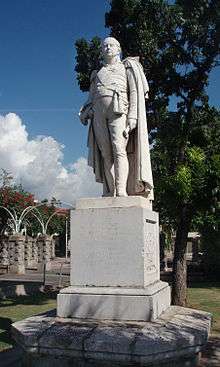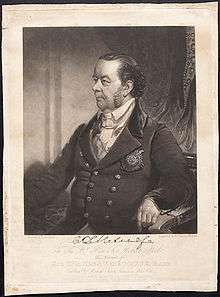Charles Metcalfe, 1st Baron Metcalfe
| The Right Honourable The Lord Metcalfe GCB PC | |
|---|---|
 Portrait by George Chinnery, early 1820s | |
| Acting Governor-General of India | |
|
In office 20 March 1835 – 4 March 1836 | |
| Monarch | William IV |
| Preceded by | Lord William Bentinck |
| Succeeded by | The Lord Auckland |
| Governor of Jamaica | |
|
In office 1839–1842 | |
| Monarch | Victoria |
| Preceded by | Sir Lionel Smith, Bt |
| Succeeded by | The Earl of Elgin |
| Governor General of the Province of Canada | |
|
In office 1843–1845 | |
| Monarch | Victoria |
| Preceded by | Sir Charles Bagot |
| Succeeded by | The Earl Cathcart |
| Personal details | |
| Born |
30 January 1785 Calcutta, Bengal Presidency, British India |
| Died |
5 September 1846 (aged 61) Malshanger, Oakley, Hampshire |
| Nationality | British |
Charles Theophilus Metcalfe, 1st Baron Metcalfe, GCB PC (30 January 1785 – 5 September 1846), known as Sir Charles Metcalfe, Bt between 1822 and 1845, was a British colonial administrator. He held appointments including acting Governor-General of India, Governor of Jamaica and Governor General of the Province of Canada.[1][2]
Family and education
Metcalfe was born on 30 January 1785 in Lecture House, Calcutta, Bengal Presidency, India, the second son of Thomas Metcalfe, then a major in the Bengal Army, who first went to India in 1767 as a cadet in the King’s Army, afterwards became a Baronet, MP, and Director of the British East India Company (1789–1812), and was created a baronet on 21 December 1802.[3][4] Thomas Metcalfe married Susannah Selina Sophia, Lady Metcalfe (1756–1815) in Calcutta in 1782, who was the daughter of a merchant, John Debonnaire, trading at Fort St. George, who subsequently settled at the Cape of Good Hope. She and her sister were educated in England and then visited their father and went on to Madras. The sister died on the voyage but Susannah married Major John Smith of the Bengal Establishment in Madras on 24 August 1776. After his death she married Major Thomas Theophilus Metcalfe in Calcutta in 1782, and the couple returned to England in 1785.[5][6] Their elder daughter was Emily Theophila, Viscountess Ashbrook (1791–1885).[7]
His Metcalfe descent can be traced back to the 14th century in Wensleydale, North Yorkshire, where the Metcalfe family originated. Having been educated at Eton, in 1800 he sailed for India as a writer in the service of the Company. He then studied Oriental languages as the first student at Lord Wellesley's College of Fort William. His younger brother, Sir Thomas Theophilus Metcalfe, 4th Baronet (1795–1853) was an agent of the Governor General of India to the Mughal court.
Career


At the age of nineteen, Metcalfe was appointed political assistant to General Lake, who was then conducting the final campaign of the Second Anglo-Maratha War against Yashwantrao Holkar. In 1808 he was selected by Lord Minto for the responsible post of envoy to the court of Ranjit Singh at Lahore; here, on 25 April 1809, he concluded the important treaty securing the independence of the Sikh states between the Sutlej and the Jumna. His first tenure as Resident at Delhi began on 25 February 1811 for the East India Company, (from 1813 for British Government), and in 1819 he received from Lord Hastings the appointment of secretary in the secret and political department. From 1820 to 1825 Sir Charles (who succeeded his brother in the baronetcy in 1822) was resident at the court of the Nizam, and afterwards was summoned in an emergency to his former post at Delhi.
Governor of Agra
On 14 November 1834 he was posted as Governor of the Presidency of Agra where he served for over four months till 20 March 1835.[8]
Acting Governor-General
In 1827 he obtained a seat in the supreme council, and in March 1835, after he had acted as the first governor of the proposed new presidency of Agra, he provisionally succeeded Lord William Bentinck as the Governor General of Bengal (1835–36). During his brief tenure of office (it lasted for only one year) he carried out several important measures, including that for the liberation of the press, which, while almost universally popular, complicated his relations with the directors at home to such an extent that he resigned the service of the Company in 1838. In 1835 he was also appointed a Knight Grand Cross of the Order of the Bath (GCB).[9]
Lieutenant Governor of the North-Western Provinces
He was Lieutenant-Governor of the North-Western Provinces from 1 June 1836 to 1 June 1838.[10][11]
Governor of Jamaica
In the following year he was appointed by the Melbourne administration to the governorship of Jamaica, where the difficulties created by the recent passing of the Negro Emancipation Act had called for a high degree of tact and ability. Metcalfe's success in this delicate position was very marked, but unfortunately his health compelled his resignation and return to England in 1842.
Governor General of the Province of Canada


Six months afterwards he was appointed by the Peel ministry to the post of Governor General of the Province of Canada and Lieutenant Governor of Canada West and Canada East from 1843–1845 with instructions to resist further development of responsible government. A clash soon emerged between Metcalfe and the leaders of the legislative assembly, Robert Baldwin and Louis-Hippolyte Lafontaine. Despite suffering from worsening cancer, he fought to preserve the prerogatives of the Crown and the governor's control over the administration and patronage. He nonetheless had to make some concessions to win support, and the most notable of these was persuading the Colonial Office to grant amnesty to the rebels of 1837-38, and to abandon forced anglicization of the French-speaking population.
Final years
Metcalfe's success in Canada carrying out the policy of the home government was rewarded with a peerage shortly after his return to England, with the title Baron Metcalfe, of Fern Hill in the County of Berkshire in 1845.[12] But his success did not endure and responsible government would be conceded by his successor James Bruce, 8th Earl of Elgin. Metcalfe died of cancer at Malshanger in Oakley, near Basingstoke, on 5 September 1846. His residence was however at Fernhill Park in Winkfield, near Windsor and it was in the parish church there that he was buried.
Honorific eponyms
- Geographic locations
See also
Further reading
References
- ↑ Half-length portrait of Sir Charles Theophilus Metcalfe (1785–1846), 3rd Baronet and 1st Baron Metcalfe, the second son of Sir Thomas Metcalfe, British Library.
- ↑
 This article incorporates text from a publication now in the public domain: Chisholm, Hugh, ed. (1911). "Metcalfe, Charles Theophilus Metcalfe, Baron". Encyclopædia Britannica. 18 (11th ed.). Cambridge University Press.
This article incorporates text from a publication now in the public domain: Chisholm, Hugh, ed. (1911). "Metcalfe, Charles Theophilus Metcalfe, Baron". Encyclopædia Britannica. 18 (11th ed.). Cambridge University Press. - ↑ Sir Thomas Theophilus Metcalfe, 1st Baronet (1745–1813). British Library.
- ↑ Prints & Drawings full record display for shelfmark P2204 British Library.
- ↑ Lady Susannah Selina Sophia Metcalfe (nee Debonnaire) (1756–1815) British Library.
- ↑ Lady Susannah Selina Sophia Metcalfe (1756–1815). Married. British Library.
- ↑ Emily Theophila, Viscountess Ashbrook (1791–1885) British Library.
- ↑ The India list and India Office list for 1905 By Great Britain, India Office #130
- ↑ "No. 19310". The London Gazette. 25 September 1835. p. 1791.
- ↑ http://www.worldstatesmen.org/India_BrProvinces.htm
- ↑ The India list and India Office list for 1905 By Great Britain, India Office #130
- ↑ "No. 20433". The London Gazette. 17 January 1845. p. 137.
Further reading
- J. W. Kaye, Life and Correspondence of Charles Lord Metcalfe (London, 1854)
- E. Thompson, The life of Charles, Lord Metcalfe (London, 1937).
 Lee, Sidney, ed. (1894). "Metcalfe, Charles Theophilus". Dictionary of National Biography. 37. London: Smith, Elder & Co.
Lee, Sidney, ed. (1894). "Metcalfe, Charles Theophilus". Dictionary of National Biography. 37. London: Smith, Elder & Co. - Bayly, C. A. "Metcalfe, Charles Theophilus, Baron Metcalfe (1785–1846)". Oxford Dictionary of National Biography (online ed.). Oxford University Press. doi:10.1093/ref:odnb/18617. (Subscription or UK public library membership required.)
External links
| Wikimedia Commons has media related to Charles Theophilus Metcalfe. |
| Government offices | ||
|---|---|---|
| New creation | Governor of Agra 1834–1835 |
Succeeded by W. Blunt |
| Preceded by Lord William Bentinck |
Governor-General of India, acting 1835–1836 |
Succeeded by The Lord Auckland |
| Preceded by A. Ross as Governor of Agra |
Lieutenant Governor of the North-Western Provinces 1836–1838 |
Vacant Title next held by Sir George Frederick Edmonstone |
| Preceded by Sir Lionel Smith |
Governor of Jamaica 1839–1842 |
Succeeded by The Earl of Elgin and Kincardine |
| Preceded by Sir Charles Bagot |
Governor General of the Province of Canada 1843–1845 |
Succeeded by The Earl Cathcart |
| Academic offices | ||
| Preceded by Sir Charles Bagot |
Chancellor of King's College 1843–1845 |
Succeeded by The Earl Cathcart |
| Baronetage of the United Kingdom | ||
| Preceded by Theophilus John Metcalfe |
Baronet (of Chilton) 1822–1846 |
Succeeded by Thomas Theophilus Metcalfe |
| Peerage of the United Kingdom | ||
| Preceded by New creation |
Baron Metcalfe 1845–1846 |
Succeeded by Extinct |